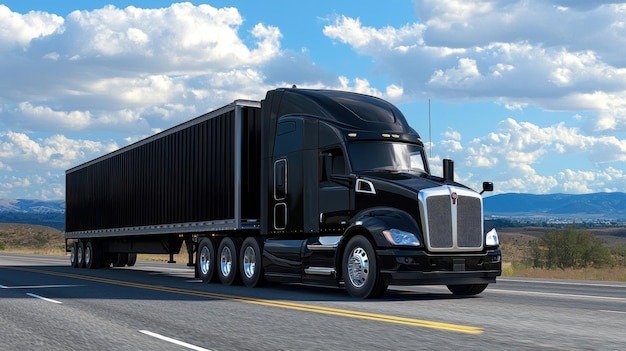
Open trailer trucks are those vehicles that carry non perishable goods in an enclosed form. It is steel or aluminum, and it protects cargo from rain, snow and theft. Dry vans find applications in a variety of goods from clothing, furniture, and electronics. They are an affordable and secure solution to several industries.
How Does a Dry Van Truck Differ from a Refrigerated Truck?
There are two types of trucks used for the transport of goods, which are the dry van trucks and the refrigerated trucks, and these are at variance from one another on a few aspects.
A dry van truck is a closed trailer that keeps goods safe from bad weather, safe from theft. It is perfect to be used when moving items that do not require special temperature control such as clothes, electronics or furniture. The inside of a dry van truck is only a simple cargo loading space inside.
On the other hand, a refrigerated truck (or “reefer”), has a cooling system. It is used delivering where goods which need to remain cold, e.g. food, medicine or flowers has to be moved. There is a tendency of having the temperature within a refrigerated truck regulated to maintain the cargo fresh.
In other words, the primary difference is control of temperature. Dry vans are for normal goods, refrigated trucks are for temperature-sensitive items.
What Types of Cargo Can Be Transported in a Dry Van Truck?
A dry van truck is for hauling various goods. These trucks are closed and secure the items within from weather, and theft.

Examples of common commodities that can be carried in a dry van truck include by way of example clothing. Clothes are… Dry van can as well protect electronics such as phones, laptops, and TVs when transported. These goods do not require special temperature control, dry vans suit them well.
Furniture is another common cargo. Dry vans are therefore used to transport couches, tables and chairs since they offer ample space. Besides, dry vans transport books and office supplies. The transport of things between places is performed using dry vans in many businesses.
Finally, building material such as wood, bricks and tiles are commonly transported in dry vans. Such goods are normally robust enough to withstand dry van for several hours.
In other words, a dry van truck is excellent for transport of things that do not require special consideration of treatment or temperature control therefore a very multi-functional means of transporting many different types of cargo.
What Are the Benefits of Using a Dry Van Truck for Shipping?
Dry van truck has many advantages for the cargo carriage. First, it keeps items safe. The truck is closed, that is, cargo is safe from the rain, snow, or theft. This is significant for valuable things.
Second, dry van trucks are cheap. They are cost effective to hire or purchase as compared to refrigerated ones. This is why they are an excellent fit for those businesses that don’t require temperature control.
Another benefit is versatility. Dry vans have a broad range of what they can transport from furniture to clothing, electronics and office supplies. This is convenient for many industries, such as retail, manufacturing and e-commerce.
Dry vans also make loading and off loading easy. They have large doors and room for permitting forklifts or pallet jacks- moving things along a faster rate.
Finally, dry van truck can make your shipping process faster. With its easy design, low cost of operation, businesses can move goods swiftly and save at the same time.
In other words, dry van trucks are safe, cost-effective and flexible and thus great for many shipping needs.
What Is the Weight Capacity of a Dry Van Truck?
A dry van truck will hold many pounds of weight. Average load carrying capacity is about 45,000 pounds. In other words, the truck is able to carry up to 45,000 pounds in weight.
Nevertheless, the total weight a dry van is capable of carrying is also dependent on the size of truck. An ordinary dry van measures approximately 53 feet. It can move a lot of cargo, but a total weight cannot exceed 80,000 pounds if you count the truck and the trailer.
It should be noted that the force of the cargo should be distributed properly for the sake of truck security and not damaging it. By default, most dry vans are designed to move standard commodities such as furniture, electronics or clothing.
There might be a light cargo; in turn more room for other goods. However, regardless of what you’re shipping, it’s always a good idea to consider the weight limits, and not overload the truck.
In other words, a dry van truck can hold about 45,000 pounds of freight, and the truck’s total weight, including the truck itself should not be more than 80,000 pounds.
How Long Is a Typical Dry Van Truck?
A standard dry van truck is normally 53 feet in length. Dry van trailers have a most common size for dry van trailers. Length helps the truck carry a large mass of cargo with it but still can drive on highways and city roads.
Some dry vans may be shorter, about 48 feet long, but the norm is 53 feet for most other shipping firms. The length provides the room to move items such as furniture, electronics or clothing.

Apart from length, a dry van truck stands in about 8.5 feet high, and 9.0-9.5 feet high. Such estimates make them spacious from the inside but convenient to drive on the road.
Size of a dry van is important as a result of assisting businesses to ship goods more efficiently. It also makes sure that the truck will be able to to enter loading docks and those areas created for regular truck sizes.
Precisely, a regular dry van truck is 53 feet in length, which means that it is perfect for treating different commodities safely and effectively.
Can Dry Van Trucks Be Used for International Shipping?
The dry van trucks are primarily used for domestic shipment, therefore, they mostly carry goods from one country to the other. They can, however, form part of the international shipping when combined with other forms of transport.
For instance, dry van truck can carry goods from a warehouse into a port. From the port, the goods are packaged into a ship for traveling abroad. Once delivered to the destination country, the goods might be unloaded from the vessel and transferred once more by dry van truck through the final destination.
This is to say that even though dry van itself never goes across oceans, it is an important part of those processes that take goods to and from international ports.
For some countries, dry van trucks can be used for cross border shipping for instance at the borders near to borders like between Canada and the U.S or between U.S and Mexico.
Put simply dry van trucks are not used for ocean transport but it can be a component of international freight when used to move cargo to and from or across the seaports.
How Much Does It Cost to Rent a Dry Van Truck?
Price for renting a dry van truck may vary depending on its destination, how long the rental will last and the size of the vehicle. Dry van rental trucks cost on average $100-$300 per day.
When you have longer to rent the truck like a week or a month, it will cost you about $1,000 – $3,000 or more. Other companies provide weekly or monthly charges that may be less for a longer lease.
Other accumulations may be included, e.g., insurance, fuel and maintenance costs. These additional charges will depend on the rental corporation as well as the miles you take, meaning that the more miles you travel, the more you’ll be paying in extra charges to supplement the main tariff.
When renting a dry van for business operations, you also need to factor in, the truck’s weight capacity and size. Generally larger trucks can be more expensive in terms of renting.
In other words, renting a dry van truck will cost $100 – 300 per day, excluding insurance, fuel, and other services. Always confirm from the company renting the rates as well as additional fees.
What Industries Use Dry Van Trucks for Transportation?
Many industries use dry van trucks to transport goods. These trucks are great for carrying items that don’t need special temperature control.
One of the biggest industries is retail. Stores and e-commerce businesses use dry vans to ship clothing, electronics, and other products to their customers. Dry vans are also commonly used in the furniture industry. They carry couches, tables, and chairs from manufacturers to stores or customers.
The food industry also uses dry vans, but only for non-perishable items like canned goods, snacks, and packaged food. Dry vans are perfect for these because they keep the food safe and dry during transport.
The automotive industry uses dry vans to move car parts to assembly plants or auto repair shops. They can carry tires, engines, and other vehicle parts.
Lastly, the construction industry relies on dry vans to transport building materials, like lumber, tiles, and cement, to construction sites.
In short, dry van trucks are used by many industries, including retail, furniture, food, automotive, and construction. They are versatile and safe for transporting a wide range of goods.




